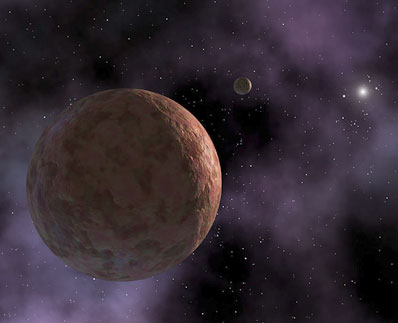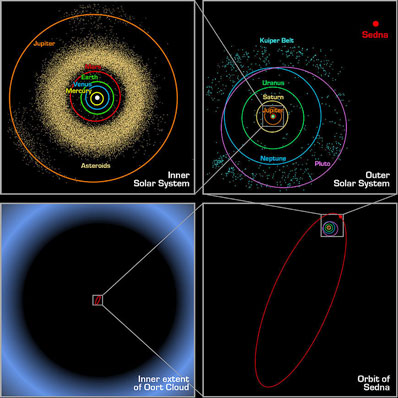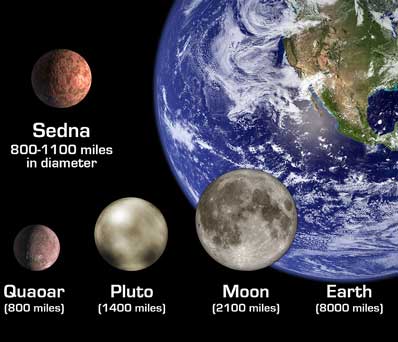NASA NEWS RELEASE
Posted: March 15, 2004
NASA-funded researchers have discovered the most distant object orbiting Earth's Sun. The object is a mysterious planet-like body three times farther from Earth than Pluto.
 An artist's concept of Sedna. Credit: NASA/JPL-Caltech Download a larger image here |
This is likely the first detection of the long-hypothesized "Oort cloud," a faraway repository of small icy bodies that supplies the comets that streak by Earth. Other notable features of Sedna include its size and reddish color. After Mars, it is the second reddest object in the solar system. It is estimated Sedna is approximately three-fourths the size of Pluto. Sedna is likely the largest object found in the solar system since Pluto was discovered in 1930.
Brown, along with Drs. Chad Trujillo of the Gemini Observatory, Hawaii, and David Rabinowitz of Yale University, New Haven, Conn., found the planet-like object, or planetoid, on Nov. 14, 2003. The researchers used the 48-inch Samuel Oschin Telescope at Caltech's Palomar Observatory near San Diego. Within days, telescopes in Chile, Spain, Arizona and Hawaii observed the object. NASA's new Spitzer Space Telescope also looked for it.
 These three panels show the first detection of the faint distant object dubbed "Sedna." Imaged on November 14th from 6:32 to 9:38 Universal Time, Sedna was identified by the slight shift in position noted in these three pictures taken at different times. Credit: NASA/Caltech Download a larger image here |
Scientists used the fact that even the Spitzer telescope was unable to detect the heat of the extremely distant, cold object to determine it must be less than 1,700 kilometers (about 1,000 miles) in diameter, which is smaller than Pluto. By combining available data, Brown estimated Sedna's size at about halfway between Pluto and Quaoar, the planetoid discovered by the same team in 2002.
The elliptical orbit of Sedna is unlike anything previously seen by astronomers. However, it resembles that of objects predicted to lie in the hypothetical Oort cloud. The cloud is thought to explain the existence of certain comets. It is believed to surround the Sun and extend outward halfway to the star closest to the Sun. But Sedna is 10 times closer than the predicted distance of the Oort cloud. Brown said this "inner Oort cloud" may have been formed by gravity from a rogue star near the Sun in the solar system's early days.
 The location and orbit of the new object is shown in context with the orbits of the Solar System, known asteroids and Kuiper belt objects, and the hypothesized Oort cloud of distant objects orbiting the Sun. Credit: NASA/Caltech Download a larger image here |
Rabinowitz said there is indirect evidence that Sedna may have a moon. The researchers hope to check this possibility with NASA's Hubble Space Telescope. Trujillo has begun to examine the object's surface with one of the world's largest optical/infrared telescopes, the 8-meter (26-foot) Frederick C. Gillett Gemini Telescope on Mauna Kea, Hawaii. "We still don't understand what is on the surface of this body. It is nothing like what we would have predicted or what we can explain," he said.
 This illustration shows Sedna in relation to other bodies in the solar system, including Earth and its Moon; Pluto; and Quaoar, a planetoid beyond Pluto that was until now the largest known object beyond Pluto. The diameter of Sedna is slightly smaller than Pluto's but likely somewhat larger than Quaoar. Credit: NASA/JPL-Caltech Download a larger image here |
NASA's Jet Propulsion Laboratory, Pasadena, Calif, manages the Spitzer Space Telescope.
Interesting how they sat on the discovery from November until today.
Distances in space are truly huge...even at Sedna's most distant position from the Sun at 84 billion miles, it is very close indeed compared to that of the nearest stars. Alpha Centauri system is 300 times farther away still!

